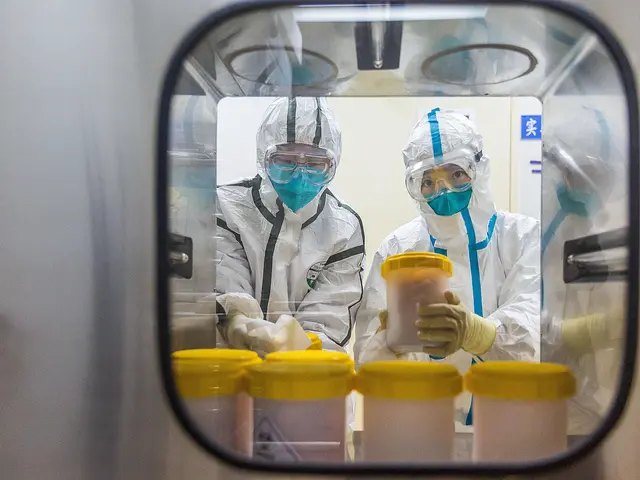Surprisingly, cylindrical potato chip containers are being used as efficient diagnostic tools by Chinese doctors on the front lines combating COVID-19.
A 37-second online video shows a doctor using an empty cylinder of Lay's potato chips covered with a piece of paper marked with the three Chinese characters "Ting Zhen Qi," meaning stethoscope, on the chest of a male patient to listen to his breathing.
The "invention" came from a group of medical workers from the General Hospital of the Central Theater Command of the People's Liberation Army, one of the largest Wuhan-based military hospitals treating COVID-19. They shared the method in an article published in the European Heart Journal in May, saying that the cylindrical containers could be used as a substitute to a traditional stethoscope.
Gao Xuhui, the lead author of the article and head of the hospital's Thoracic Cardiovascular Surgery Department, said stethoscopes are irreplaceable in treating respiratory diseases, especially COVID-19.
"In the outpatient clinic, doctors use stethoscopes to evaluate the patient's lungs to determine whether there is an infection. In the ward, patients' conditions could change at any time, and doctors need to respond quickly to find out why, which also requires the use of stethoscopes," Gao said.
Since the COVID-19 outbreak, his team has used the method to examine more than 300 patients and save four lives through timely diagnosis.
However, Gao's opinions seem contrary to an article titled "COVID-19 outbreak: less stethoscope, more ultrasound." Published in the journal The Lancet Respiratory Medicine in March, the article by Italian scholars highlighted that the use of lung ultrasound could ensure medical workers' safety better than the stethoscope.
"There is nothing wrong with what they are claiming, but this view may mislead doctors to give up using their stethoscopes," Gao replied.
He admitted that heavy protective suits and face shield make it difficult for doctors to insert conventional stethoscopes in their ears. Even if the stethoscope is put into protective suits in advance, it will be used on multiple patients, leading to an increased risk of virus infection.
Bluetooth devices and handheld ultrasound imaging equipment can lower the risk of virus infection, but they are costly and scarce.
Gao's team did point out that relying on ultrasound equipment was not suitable for preliminary diagnosis or real-time monitoring of patients, especially in clinical emergencies.
Advanced technologies cannot wholly replace basic examination methods such as a stethoscope. In an emergency, a stethoscope as a bedside tool can help doctors save lives in a more timely manner than ultrasound equipment, Gao said.
Therefore, the medical staff created the make-shift stethoscopes to aid in diagnosis and as an external interface for connections with patients.
Co-author Tan Yan, also an intensive care unit doctor at the hospital, came up with the idea. He was inspired by a cartoon showing a doctor using a wooden tube to auscultate patients.
At first, Tan chose a tube for shuttlecock, but the effect was not good as the tube was too long. After several trials, he found the cylindrical potato chip containers to be the most suitable.
"Our article does not present any profound theoretical research, but it discusses a 100 percent scientific problem," Gao said in an interview.
"Replacing a stethoscope with a paper tube can help medical staff battled on the front lines and in remote areas with equipment shortages."
 简体中文
简体中文

